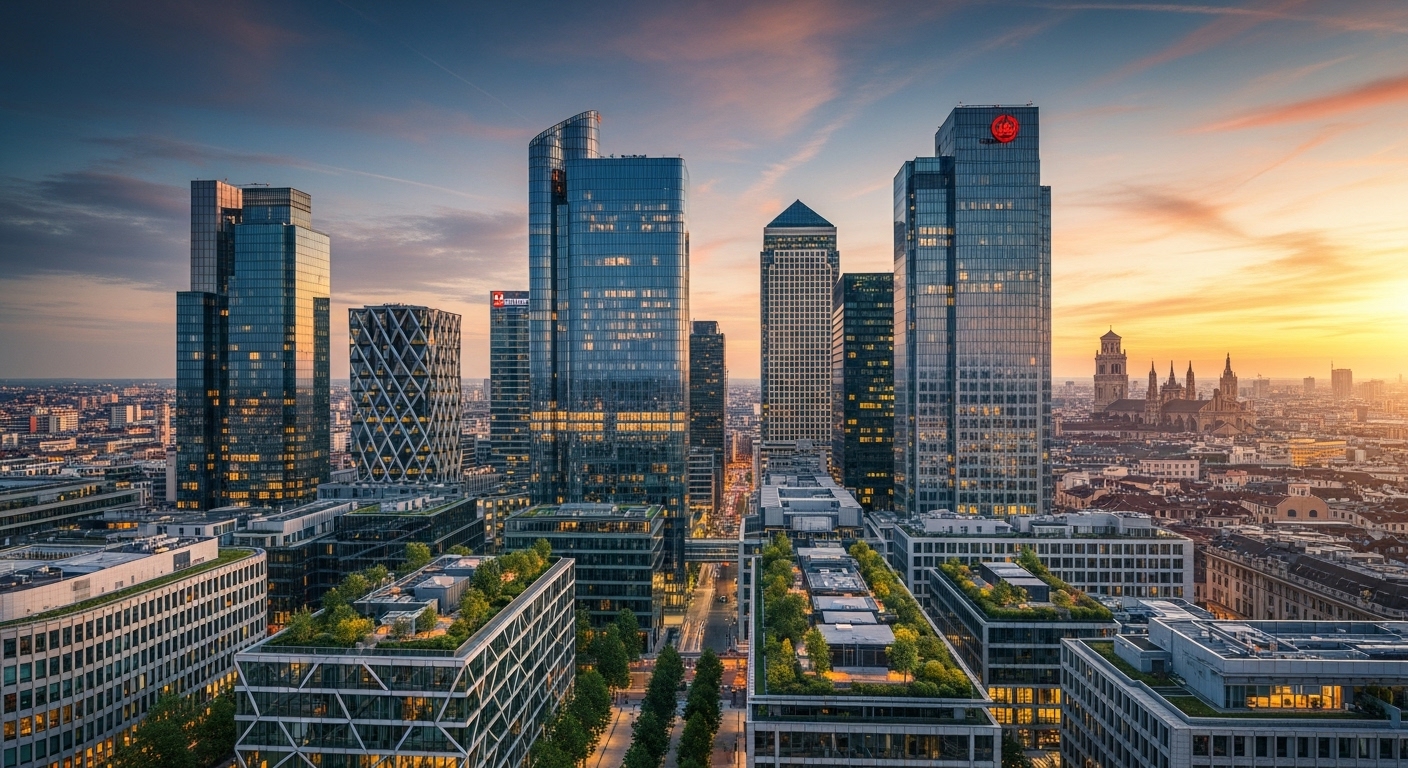The traditional image of a European business district—a dense cluster of monolithic glass towers housing the world’s financial giants—is rapidly becoming outdated. In a post-pandemic world shaped by hybrid work, technological disruption, and a pressing need for environmental responsibility, the metrics for what makes a premier business location have fundamentally shifted. It’s no longer enough to be a hub of capital; today’s leading districts must also be magnets for talent, incubators for innovation, and models of sustainability. This evolution reflects a broader change in corporate strategy, where quality of life, digital connectivity, and green credentials are now as crucial as market access and financial infrastructure. This analysis moves beyond legacy reputations to rank Europe’s premier business districts on the modern trinity of talent, technology, and sustainability. We will explore how established powerhouses like London and Paris are adapting and how agile challengers like Amsterdam and Dublin are setting new benchmarks for the future of work.
Redefining the central business district: beyond the skyline
The very concept of the Central Business District (CBD) is undergoing a profound transformation. Historically defined by its commercial density and concentration of corporate headquarters, the modern CBD is being reshaped by powerful global forces. The widespread adoption of flexible and hybrid work models means the office is no longer just a place for individual tasks but a hub for collaboration, culture-building, and innovation. This requires a different kind of environment—one that is not only accessible but also engaging and amenity-rich. Companies are increasingly looking for locations that offer more than just office space; they want vibrant ecosystems that help attract and retain top talent. This includes high-quality public transport, green spaces, cultural venues, and a diverse range of retail and dining options. Furthermore, the digital revolution has made robust technological infrastructure a non-negotiable requirement. A leading business district must provide seamless, high-speed connectivity and support a thriving tech ecosystem, from startups to established tech giants. Finally, the growing importance of Environmental, Social, and Governance (ESG) criteria is placing sustainability at the forefront of location decisions. Businesses are under pressure from investors, consumers, and employees to operate responsibly, making districts with certified green buildings, renewable energy sources, and a commitment to sustainable urban planning immensely more attractive. These new criteria are creating a more complex and competitive landscape where the most successful districts are those that can offer a holistic value proposition that balances economic dynamism with human well-being and environmental stewardship.
The enduring giants: London’s City and Canary Wharf
Despite the seismic shifts of Brexit and the global pandemic, London remains a formidable force on the European business stage. Its twin hubs, the historic City of London and the modern Canary Wharf, demonstrate a remarkable capacity for adaptation. The City, with its unparalleled concentration of financial, legal, and professional services, continues to benefit from a deep, specialized talent pool that is difficult to replicate. While some banking roles have shifted to the continent, London’s dominance in areas like asset management, fintech, and insurance remains secure. The City Corporation is actively working to enhance the district’s appeal beyond the 9-to-5, promoting cultural initiatives and improving public spaces to create a more vibrant, 24/7 environment. Meanwhile, Canary Wharf, once a pure financial monolith, has successfully diversified its tenant base. It is now a major hub for technology and media companies, alongside its traditional financial occupants. The district’s evolution is a masterclass in strategic reinvention; the addition of the Elizabeth Line has dramatically improved connectivity, while a significant increase in residential, retail, and leisure developments has transformed it into a genuine mixed-use neighborhood. This transition from a corporate enclave to a dynamic urban center is key to its future resilience, helping it attract a new generation of workers who demand a seamless integration of work, life, and leisure.
Paris La Défense: Europe’s largest purpose-built powerhouse
As the largest purpose-built business district in Europe, Paris La Défense has long been a symbol of corporate might. Its iconic skyline, home to the headquarters of many of France’s largest companies, represents a significant concentration of economic power. In the post-Brexit landscape, La Défense has emerged as a key beneficiary, attracting major financial institutions like the European Banking Authority and various divisions of global banks seeking a secure foothold within the EU. However, the district’s leadership understands that its future success depends on more than just scale and location. A massive multi-billion euro renewal plan is underway to transform La Défense from a concrete-heavy business park into a more human-centric, sustainable, and connected urban quarter. This strategy involves breaking down the barriers between the business district and surrounding residential areas, introducing new green spaces, and modernizing its infrastructure. A key focus is on mixed-use development, with plans to add thousands of new homes, shops, restaurants, and cultural facilities to foster a sense of community and vitality outside of traditional office hours. The district is also aiming to become the world’s first post-carbon business district, a bold ambition that involves retrofitting older buildings for energy efficiency, promoting sustainable transport, and investing in renewable energy. This forward-thinking approach is designed to ensure La Défense remains competitive by appealing to businesses and talent that prioritize sustainability and a high quality of urban life.
Frankfurt’s Bankenviertel: the continental finance capital
Frankfurt’s Bankenviertel, or Banking Quarter, has cemented its position as the European Union’s undisputed financial capital. Home to the European Central Bank (ECB), the Deutsche Bundesbank, and a host of international financial giants, the district’s influence has only grown following Brexit. Dozens of banks have relocated significant operations and staff to Frankfurt to maintain access to the EU single market, drawn by Germany’s stable economy and the city’s robust financial ecosystem. The district’s strength lies in its exceptional connectivity—Frankfurt Airport is one of the busiest in the world, providing direct links to global markets—and its high concentration of financial expertise. However, Frankfurt is not resting on its laurels. The city is actively cultivating a burgeoning FinTech scene, creating a symbiotic relationship between established banking institutions and agile tech startups. This is fostering an environment of innovation that is crucial for the future of finance. Furthermore, the city skyline, often nicknamed ‘Mainhattan,’ is constantly evolving with new, sustainable high-rises that meet the highest environmental standards. Unlike some of its more sprawling competitors, the Bankenviertel is remarkably compact and walkable, integrated seamlessly into the wider city fabric, offering residents and workers easy access to Frankfurt’s rich cultural offerings, from museums to the historic old town. This blend of financial power, technological innovation, and high livability makes Frankfurt a compelling and stable choice for businesses at the heart of Europe.
Amsterdam’s Zuidas: the strategic challenger
Amsterdam’s Zuidas (South Axis) has rapidly emerged as one of Europe’s most dynamic and attractive business districts, punching well above its weight. Its strategic location, situated between the city center and Schiphol Airport, offers unparalleled connectivity, making it a gateway to both the Netherlands and the rest of the world. Zuidas has become a magnet for international corporations, particularly in the legal, financial, and tech sectors, drawn by the Netherlands’ business-friendly environment and highly skilled, English-proficient workforce. What sets Zuidas apart is its master-planned approach to urban development, which prioritizes quality of life and sustainability alongside commercial growth. Unlike older, more monolithic business districts, Zuidas is designed as a complete urban neighborhood. It seamlessly integrates state-of-the-art office buildings with high-quality residential apartments, world-class restaurants, cafes, and green public spaces. This mixed-use model creates a vibrant, energetic atmosphere that appeals to modern talent seeking a healthy work-life balance. Sustainability is also a core tenet of its design, with a strong focus on energy-efficient buildings, excellent public transport links, and extensive cycling infrastructure. The district’s continued development, which includes plans to cover the main motorway to create a vast new park, underscores its commitment to creating a future-proof, human-scale environment. Zuidas represents a new paradigm for business districts, proving that economic success and exceptional livability can go hand in hand.
The rising stars: spotlight on Dublin and Milan
Beyond the established giants, a new tier of dynamic business districts is capturing global attention. In Dublin, the Silicon Docks area has become the undisputed European headquarters for many of the world’s largest technology companies. This cluster effect has created a vibrant tech ecosystem fueled by a young, highly educated, and international talent pool. Ireland’s favorable corporate tax regime has certainly been a catalyst, but the city’s energetic culture and thriving startup scene are equally important factors in its success. The district is characterized by modern architecture built alongside the historic Grand Canal Dock, symbolizing the fusion of Ireland’s rich heritage with its high-tech future. Meanwhile, Milan’s Porta Nuova district stands as a testament to Italy’s economic and design prowess. Spearheaded by landmark projects like the Bosco Verticale (Vertical Forest) towers, Porta Nuova is a global benchmark for sustainable urban regeneration. The district has successfully revitalized a once-neglected part of the city, transforming it into a premier hub for finance, fashion, and technology. It masterfully blends cutting-edge, LEED-certified skyscrapers with expansive pedestrianized zones, public parks, and cultural venues. Porta Nuova’s success lies in its focus on creating a high-quality, aesthetically pleasing environment that attracts both multinational corporations and top talent, solidifying Milan’s status as a key business destination on the continent.
In conclusion, the landscape of European business districts is more diverse and competitive than ever before. The era of a single, dominant financial center is over, replaced by a polycentric network of specialized hubs, each with unique strengths. London’s deep talent pool and Paris’s sheer scale ensure their continued relevance, but they face intense competition from agile and forward-thinking districts. Frankfurt has unequivocally claimed the title of the EU’s banking capital, while Amsterdam’s Zuidas has set a new standard for integrating business with an exceptional quality of life. Meanwhile, rising stars like Dublin’s Silicon Docks and Milan’s Porta Nuova demonstrate the power of specializing in high-growth sectors like technology and sustainable design. The unifying thread among these successful districts is their recognition that the future of work is human-centric. The battle for corporate investment and relocation will be won not by the districts with the tallest skyscrapers, but by those that offer the most compelling ecosystems for talent. This means prioritizing world-class digital infrastructure, embedding sustainability into every aspect of planning, and creating vibrant, mixed-use environments where people genuinely want to work, live, and connect. For any global business considering its European footprint, the choice is no longer about a single city, but about which of these dynamic ecosystems best aligns with its strategic goals and corporate values.





